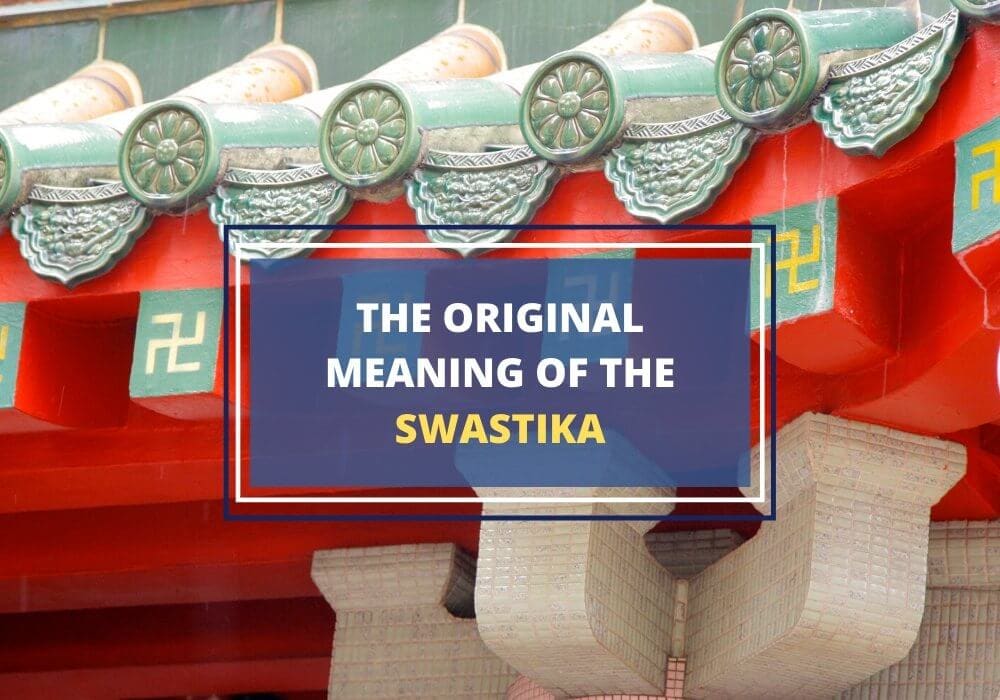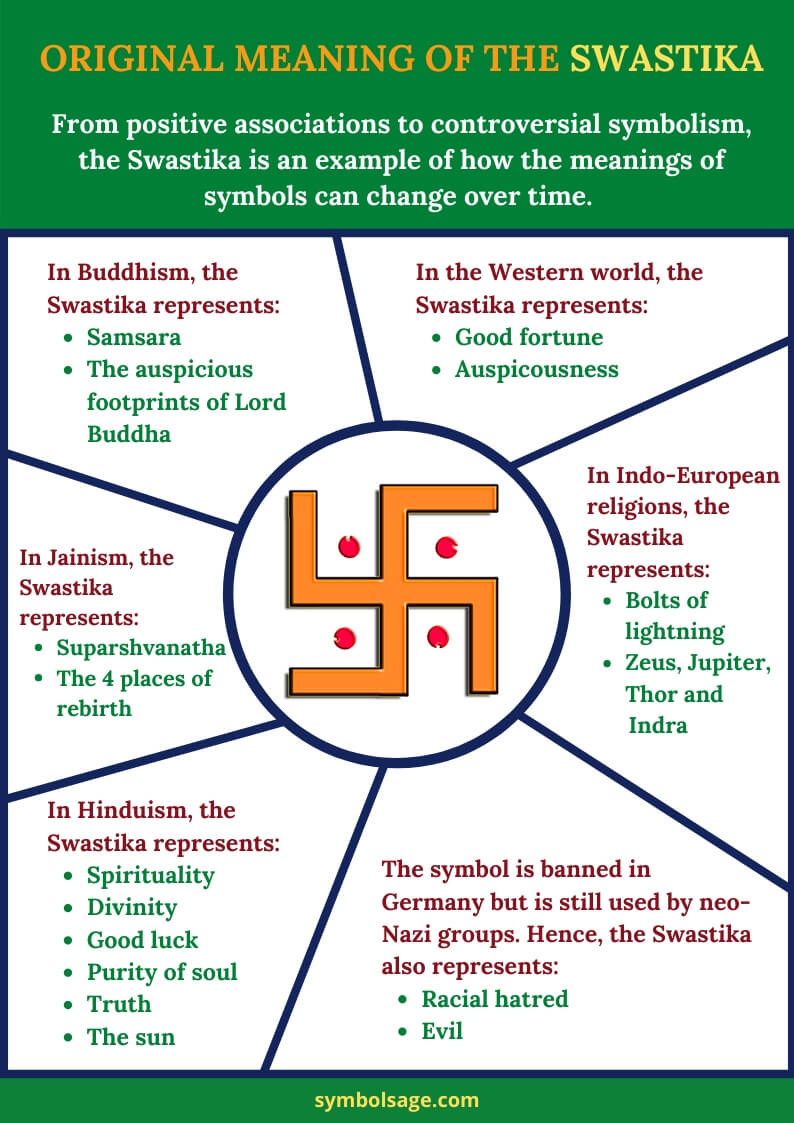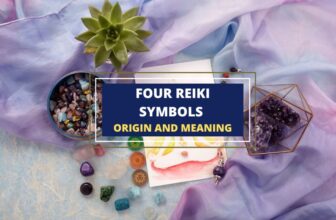
Table of Contents
When someone says the word ‘Swastika’ (卐 or 卍), what instantly comes to mind is the clockwise facing geometrical symbol of a cross with bent arms featured on the German national flag and the Nazi party. For many, the Swastika is a symbol of hatred and fear.
However, the Swastika is an ancient, religious symbol in Eurasian cultures, worshipped by many all over the world.
In this article, we’ll be exploring the original symbolism of the Swastik and how it was corrupted into the symbol of hatred that it is known for today.
History of the Swastika
The Swastika is known by several names outside the Indian subcontinent including:
- Hakenkreuz
- Gammadion Cross
- Cross Cramponnee
- Croix Gammee
- Fylfot
- Tetraskelion
The symbol was used about 5,000 years before Adolf Hitler adopted it as an icon of Nazi propaganda. According to findings from archaeological digs, it seems that the symbol was first used in Neolithic Eurasia.
The earliest appearance of the Swastika was said to be in 10,000 BCE, found in Ukraine and carved on a small, ivory figurine of a little bird. It was found near certain phallic objects, so some believed that it was a symbol of fertility.
Swastikas had also been found in the Indian subcontinent during the time of the Indus Valley Civilization and there is a theory that from there it moved to the West: to Scandinavia, Finland and other European countries. It’s hard to say exactly where the symbol originated since it was also found on pottery items in Africa, China and even in Egypt around the same time.
Today, the Swastika is a common sight on houses or temples in Indonesia or India and a sacred symbol in Buddhism, Hinduism and Jainism.
Swastika Symbolism and Meaning

The Swastika, a Sanskrit word meaning ‘conducive to well-being’, is drawn in two ways: left-facing or right-facing. The right-facing version of the symbol is what is commonly known as ‘Swastika’ whereas the left-facing version is called the ‘Sauwastika’. Both versions are widely respected especially by Buddhists, Hindus and Jains as an important religious symbol.
There are several variations of the Swastika with diverse geometrical details. Some are compact crosses with short, thick legs, some with thin, long ones and others with curved arms. Although they look different, they all represent the same thing.
The Swastika has different interpretations in different religions and cultures. Here’s a quick look at the significance of the sacred symbol:

- In Hinduism
Among Hindu symbols, the Swastika is a symbol of spirituality and divinity and is commonly used in marriage ceremonies. It’s also said to symbolize good luck, purity of soul, truth and the sun.
The rotation of the arms in four directions represents several ideas but primarily stands for the four Vedas which are harmonious as a whole. Some say that the Sauvastika symbolizes the night or the doctrines and principles of Hindu tantras.
The practices and prayers associated with the symbol were said to purify places where rituals were held and to protect the wearer of the symbol from evil, misfortune or illness. It was also believed that the symbol would invite prosperity, auspiciousness and peace into one’s home, body and mind.
- In Buddhism
The Swastika is said to be an iconic Buddhist symbol representing Lord Buddha and his auspicious footprints in several parts of Asia including Mongolia, China and Sri Lanka. The shape of the symbol represents eternal cycling, which is a theme found in the doctrine of Buddhism known as ‘Samsara’.
The Sauvastika is equally sacred and revered in the Mahayana and Bon Buddhist traditions although the clockwise version of it is the most common. Sausvastika is seen specially in the tradition of Tibetan Bon.
- In Jainism
In Jainism, the Swastika is the symbol for the Suparshvanatha who was the 7th saviour, philosopher and teacher of the dharma. It’s considered to be one of the astamangala (8 auspicious symbols). Every Jain temple and holy book has the symbol in it and religious ceremonies are usually begun and ended by creating the Swastika mark many times around the altar using rice.
The Jains also use rice to create the symbol in front of certain religious statues before placing offerings on it. It’s believed that the 4 arms of the symbol represent the 4 places where rebirth of the soul takes place.
- In Indo-European Religions
In many of the main Indo-European religions, the Swastika is said to symbolize bolts of lightning, thus representing several gods of each of the ancient religions. These include the following:
- Zeus – Greek religion
- Jupiter – Roman religion
- Thor – Germanic religion
- Indra – Vedic Hinduism
- In the Western World
The Swastika was a symbol of good fortune and auspiciousness even in the Western World until it became a feature of the Nazi flag. Unfortunately now, many people of the West still associate it with Hitler, Nazism and anti-Semitism.
- In Nazism
The ancient, auspicious Swastika symbol later turned into a symbol associated with racial hatred after it was used by Adolf Hitler in the 20th century. He understood the symbol’s power and believed that it would give the Nazis a strong foundation that would bring them success. He designed the Nazi flag himself using the colors red, black and white from the German imperial flag with the Swastika in the center of a white circle.
Since the Nazi flag is associated with hatred and evil under which a dreadful war raged and millions of Jews were brutally murdered in the Holocaust, the Swastika symbol is now viewed as a symbol of hatred and evil. Although its use as a Nazi symbol ended with World War II, it’s still favored by the neo-Nazi groups. It’s banned in several countries including Germany where the use of it is completely illegal.
The Swastika in Jewelry and Fashion
The black mark which was attached to the Swastika is gradually being lifted. It’s sometimes used on various accessories. It’s still considered a symbol of peace, luck and wellbeing and is quite a popular design for good-luck charms. There are many brands and jewelry stores that display Swastika pendants and ring designs made in both gold and white, as a way to reclaim the symbol.
However, in some parts of the world, wearing a piece of jewelry or a clothing item featuring the Swastika can be mistaken for a reference to the Nazis and provoke controversy so it’s important to keep this in mind.
In Brief
More famous as the symbol of the Nazi party than the ancient, religious symbol that it is, the Swastika is slowly re-claiming its original meaning. However, in the minds of some, the terror associated with it will never fade.
Ignoring its beautiful heritage, many people tend to associate the Swastika with its most recent and horrific meaning. However, it still remains a sacred and revered symbol in many parts of the world associated with good health, happiness and the common good.








